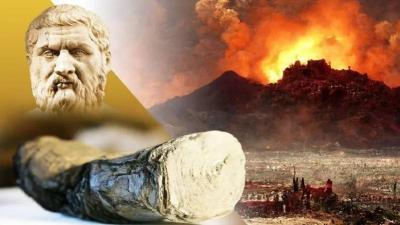A charred scroll made of papyrus, which was buried under meters of ash from the eruption of Mount Vesuvius 2,000 years ago, has revealed how Plato spent his final hours. The scroll, which was found last week, contains a description of an unknown account of how one of history's most influential figures spent his last night, listening to music played on a flute by a Thracian slave and dancer, and critiquing her sense of rhythm.
According to the leader of the team that recovered the scroll, Professor Graziano Ranocchia, a specialist in papyrus manuscripts at the University of Pisa, the discovery indicates that Plato "was, even in his final hour, capable of expressing his aesthetic judgment," based on what the professor said about the philosopher, who was a student of Socrates and a teacher of Aristotle, and who died that night at the age of 81 on his birthday.
Analysis of the scroll revealed that Plato was buried in the garden designated for him at the "Academy," a famous university he founded in 387 BC near the sacred building of Museion, which was dedicated to the Muses in the outskirts of Athens, and is no longer standing among the ruins. According to Ranocchia, who also stated, "Compared to previous editions, there is now a text that has been almost radically changed, implicitly indicating a number of new and concrete facts about various academic philosophers."
The description is part of the Academy's history by the Greek poet and philosopher Philodemus, who lived in the first century BC, "making it the earliest history of Greek philosophy we possess," according to Professor Ranocchia about the contents of the scroll, which was unreadable because it was made of papyrus, charred, and completely illegible. It was preserved in a large villa at the "Herculaneum" building discovered in 1750, which belonged to Julius Caesar's father-in-law. Since then, generations of scholars have sought ways to read the contents of the scroll until technology was developed that allowed most of it to be read.
The Italian professor and his colleagues are the first to decode the scroll in 20 centuries, using a range of techniques, including hyperspectral imaging with shortwave infrared, which revealed minor differences in how light reflected off the black ink and the black papyrus it was written on, and also demonstrated that Plato did not die while attending a wedding feast.




